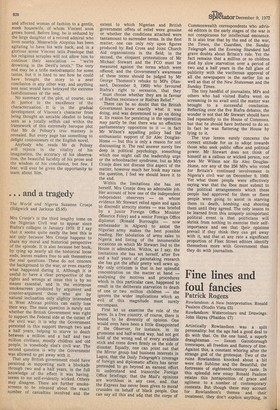Fine lines and foul fancies
Patrick Rogers
Rowlandson: A New Interpretation. Ronald Paulson (Studio Vista E5) Rowlandson: Watercolours and Drawings. John Hayes (Phaidon £7) Artistically Rowlandson was a split personality: but the age had a good deal to do with that. On the one hand, a superb draughtsman — lissom Gainsborough treescapes, all freedom and fluency of line. Against this, a constant whoring after the strange god of the grotesque. Two of the ruins Rowlandson knocked about a bit were the Sublime and the Beautiful, the fortresses of eighteenth-century taste. In this splendid new essay Ronald Paulson relates this juxtaposition of grace and ugliness to a number of contemporary contexts. But though these may account for Rowlandson's themes and their treatment, they don't explain anything, in the sense of making the drawings seem less odd.
Take for instance the artist's interest in accidents: overturned coaches, collapsing theatres. Paulson says that such scenes "in which chaos breaks loose, show a moment of transition." A taste for contingencies, stray happenings, is then related to picturesque theory. The key figure here is William Gilpin, who wished to take a mallet to Tintern Abbey and make it
properly ruinous. Rowlandson ended up by satirising Gilpin ' in his Doctor Syntax
plates. But by then the damage was done. Early Romantic aesthetics, which Rowlandson swallowed, gave deformity a sovereign imaginative value.
Then there is the Beauty and the Beast idea, which Rowlandson used directly and indirectly. Paulson is very good on this; but again he can take more than I am able to do. Rowlandson's work is stuffed with ogres, A large part of humanity is seen as goitred, gouty, leprous or crazed. In Vauxhall Gardens it is the crippled observers we first note, rather than the comely performers. The fashionable belles have got foul old fancy-men. This is the archetypal Rowlandson situation — hags eyeing pretty boys, luscious young girls dogged by misshapen lechers.
Now Paulson thinks all this ogling is a kind of voyeurism. It's got to do with 'the intensity of looking" and "the curious interplay of seeing and being." Well, maybe: though I suspect that the carnal desires of these blatant beasts are much less deviant than that. There is an apt illustration in The English Dance of Death, where the coquette at the looking-glass finds death bearing down on her, hideously disguised as a beau. A good clue there to changing taste. In the earlier eighteenth century, Beau Nash had dressed flashily but acted repressively, running the amuse ments of Bath like a cheerful prison governor. Brummell dressed conservatively, even starchily, but he behaved with the utmost freedom on his way to prison, exile and imbecility. Once, the beau had been decorous but looked flamboyant.
By Rowlandson's time it had been reversed — he acted wildly but looked prim. The beautiful people had a life-style but no costume. Handsome was as unhandsome did: hence the cult of Byron, physically (as Coleridge morally) a damaged archangel.
In spite of these disagreements, I find Paulson's book an admirable one. It is certainly the most intelligent and search ing approach we have been given. An amazing number of ideas are packed into a Short compass. It is almost too densely allusive in places; the reader needs to know his way around the drawings before he starts. But the insight and learning make up for that. Paulson is especially good at forging concrete links between Hogarth and Rowlandson, a line of descent more often asserted than demonstrated. John Hayes also has excellent things to say when he gets to the pictures. Regrettably he is delayed by some clumsily organised snatches of the ill-documented biography. However, there are the plates — well up to Phaidon standard, finely reproduced and pleasantly set on the page. Books will soon cost as much as coffeetables, but by current standards neither of these is exorbitant in price. It is hard to regret the world we have lost, as Rowlandson depicts it. Even The Microcosm of London shows men and women as maladroit extras on the noble classical set designed by Pugin. People seethe, collide, trip over themselves. Only the military, by a sinister decree, keep any sort of order. Otherwise we have an array of bruisers and bawds sullying the smooth lines of nature. What Rowlandson records is the decline of elegance as a human aspiration.











































 Previous page
Previous page